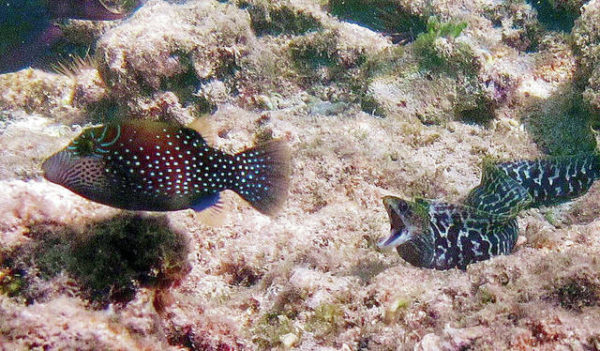Published in the Ocean Watch column, Honolulu Star-Advertiser © Susan Scott
March 31, 2018
It’s a fish-eat-fish world out on the reef, so seeing one species chase another isn’t usually a sight that has my heart pounding as I fumble for my camera. But this time the predator was scary and the prey poisonous. A moray eel was chasing an Ambon toby.
Tobies are brightly colored puffer fish, 4 to 6 inches long, belonging to the family Tetraodontidae. The name refers to tetrodotoxin, or TTX, which is one of most powerful nerve poisons in nature, deadlier than cyanide.
 An undulating moray eel chasing an Ambon toby.
An undulating moray eel chasing an Ambon toby.
©2018 Susan Scott
TTX kills fish, mammals, crustaceans and insects. Dogs have died after biting into puffer fish washed up on beaches, and flies feasting on dead puffer fish die by the droves. People also sometimes die after eating puffer fish, which is called fugu in Japanese. Puffer fish meals have killed at least seven people in Hawaii who prepared and ate their own fish.
The Ambon toby, named after the Indonesian island, Ambon, is native to the Indian and Pacific oceans. This little beauty is fairly common in Hawaii, usually in rocky areas close to shore. Also inhabiting shallow areas of boulders and coral debris are moray eels.
The eel I saw dart from its hiding place when the toby passed is called an undulating moray, Hawaiian name puhi lao milo (“leaf of the milo tree”). The species, also widespread in the Indian and Pacific oceans, grows to nearly 4 feet long and is one of our more aggressive eels. Undulated morays’ long, narrow jaws are full of sharp teeth, including a row down the mouth’s center.
Like most morays, this species is active at night but also hunts during the day, so seeing one midmorning wasn’t a surprise.
Pursuing the toby, however, was. Tobies have a skin toxin that repels predators, and, like other puffer fish, can inflate their bodies with water or air when distressed, becoming too big to swallow.
Tobies’ unusual shape and bright colors warn predators that they’ll be sorry if they eat them. Sometimes this learning is genetic, with survivors passing the aversion to offspring through the selection process of evolution.
In other cases it takes trial and error to learn the lesson. If the moray bit the nasty-tasting toby and survived, it wouldn’t do it again.
My moray, 2 to 3 feet long, however, did not catch the toby. The little puffer fish dashed into a rock pile, and the eel, for some reason, ducked into a different hole and disappeared.
My presence may have disturbed the chase, but it’s also possible the eel suddenly remembered that tobies leave a bad taste in the mouth.
In the past I’ve sometimes forgotten my camera when I’ve gone snorkeling. No more. After catching this little fish drama, the camera is an essential part of my gear.